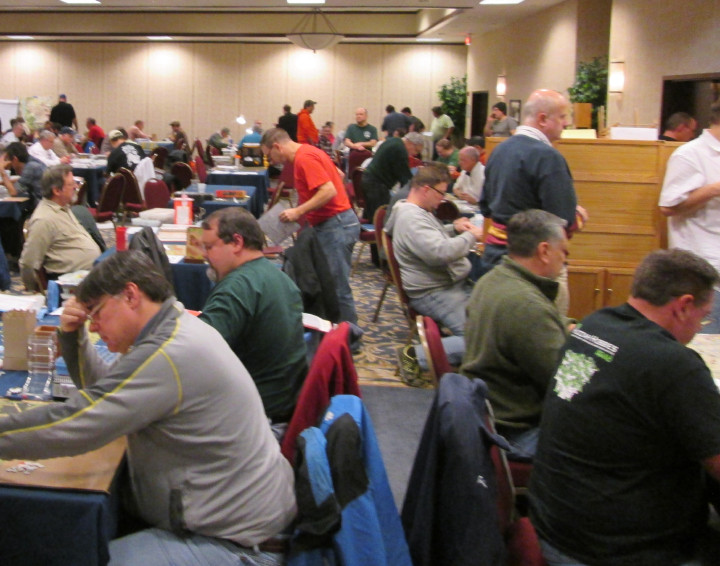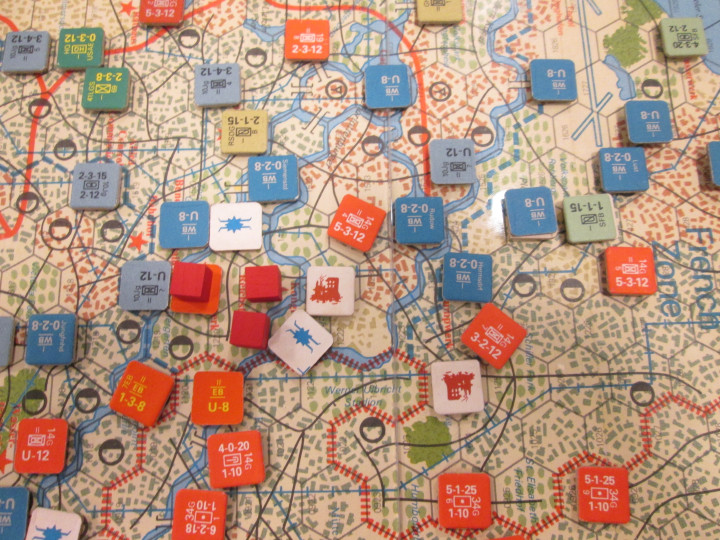How many wargamers can you fit in 4,500 square feet of conference space, assuming you factor in room for tables, chairs, dice towers, and a keg? At least 165 if you were at Winter Offensive 2015 in Bowie, Maryland, the latest installation of the East Coast’s premier Advanced Squad Leader tournament, held annually over Martin Luther King, Jr. Day weekend.

This year’s event saw the most attendees ever, nearly twenty more than last year’s record crowd. By noon on Saturday, all available table space seemed to have filled up, though most people were happy to share space. Attendance was likely boosted by the debut of the long-awaited “final” core module for ASL, Hakkaa Päälle, which (re)introduces the Finns to the tactical gaming system.
The printing on the new Finnish counters came out quite nicely, and the light grey color chosen works well in the system, as long as you don’t have them fighting the Italians, who share the same counter palette. The counter material also rounded quite nicely, as I brought my handy-dandy deluxe counter corner rounder with me to the tournament for the express purpose of clipping the Finns. Quite a few people stopped by and asked about the labor-saving wonder device, which gently rounds off the otherwise nubby edges to produce an aesthetically pleasing and easily manipulable counter. I dare say I converted at least a few people to the church of Oregon Laminations (just in case there’s a rounder referral rewards program I don’t know about…).

I had the privilege of taking the fresh Finns out for a spin against regular gaming chum and all-around good guy Mike Vogt, who had the Soviets on defense in 172 “The Last Attack,” a scenario chosen almost entirely because one of the Finnish leaders enters the game on a bicycle. He didn’t last long, but the match went almost to the end. Mike set up a canny defense (and employed some absurd fire discipline) and was able to slow my progress enough to hold one of the required victory conditions for a well-deserved win. We had a series of interminable melees that I kept pouring units into, only to see them ground up. Probably not the best strategy, but a greater principle was at stake. I was not going to lose those melees. I did, of course, but that’s beside the point. A pleasure as always playing against Mike.
Long-time opponent Doug Bush provided the other major gaming event of the tournament for me, our traditional all-day non-ASL match. Following on last year’s playing of SPI’s BAOR, we switched to a tighter scale with SPI’s Berlin ’85, covering a hypothetical attempt by the Warsaw Pact to overrun the NATO West Berlin garrison at the start of WW III. The map, a Simonsen classic, took some getting used to, with its welter of colors and symbols depicting the various types of city terrain and transportation routes, but after a point, they became comprehensible and showed well under the counters. I have a real fondness for the SPI counters from this era, with their crisp lettering and glorious colors.

The combat system reflects the game’s early ’80s pedigree, with locking Zones of Control, mandatory attacks, and a heavy reliance on retreat results. I still managed to lose quite a few Soviet mechanized battalions to ill-advised attacks against West Berlin police units holed up in heavy urban terrain, and while my East Germans managed a sweeping thrust from Potsdam into the American Sector that threatened to unhinge the NATO defense, Doug managed to hold off my attacks long enough to edge out a Marginal Victory once NATO succumbed to a surrender roll. Both Doug and I agreed that the game deserves another playing, as the system contains a few subtleties that, once grasped, allow for a different tactical approach. A real gem against a great opponent, and a game I’m happy to have added to the played list.
As ever, I managed to get in some side gaming as well, more this year than ever before. Group favorite Pax Porfiriana made the table three times (and, it must be said, I somehow won all three, leading to a prohibition against my playing it anymore). Mike introduced everyone to Panamax, a game about shipping through the Panama Canal. That game, a cross between worker placement style action choices and 18XX financial manipulation, hit the table to rave reviews and got played a good three times. A Study in Emerald came out on Friday night, with the Restorationists solidly thumping the Loyalists, who made their move about a turn too late. I had the honor in that one of putting a stake through the heart of Vampire Sherlock Holmes.
And, of course, the annual playing of Battlestar Galactica on Saturday night ended with, as always, a Cylon victory. The humans were done in by the cagey play of John Slotwinski, who held the Admiral card and concealed his robotic nature long enough to jump the human fleet into the middle of nowhere for the win. We used the Pegasus expansion, adding another Battlestar and Cylon Leaders to the game. The new rules didn’t add much complexity and worked well with six players, but with our standard five player games, I’d opt to use the base rules alone.
My thanks to the team at Multi-Man Publishing for another fine Winter Offensive, and to all my opponents for three days of amazing, and exhausting, gaming.



 I managed to game aplenty, though. After spending much of Thursday catching up with people, I spent the vast majority of Friday playing a huge scenario from GMT’s
I managed to game aplenty, though. After spending much of Thursday catching up with people, I spent the vast majority of Friday playing a huge scenario from GMT’s 


